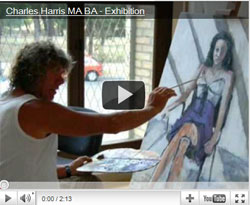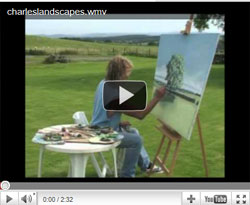Charles Harris Professor
Charles holds a Royal Academy Master of Arts Degree, which the RA consider the equivalent of a PHD.
While following Master Classes overseas, America, China, and in particular in Italy, with his practical coaching and lectures in Art Schools, where people were embarrassed he was still further qualified without the rank, it was therefore suggested he accept/adopt the title of Professor. (Traveling.)
He was already considered an authority on Italian Classical Renaissance Painting, before those talks he gave on the subject of Renaissance Painting for three consecutive years for the Italians at Earls Court and Olympia in London, and before the publication of his book entitled, ‘ Trust Your Eye an Illustrated History of Painting, ‘ which is now to be found in the top libraries in Britain and overseas.
This is important, for most art courses at our universities in Britain today are still intensely pro modern art in approach and staffing, especially here in Scotland.
The Lone Voice in the Wilderness for Traditional Art
Today, Charles Harris MA BA, professional British artist, is the centre of a new cult following in Art.
With his painting – in an almost quiet way, he has become one of the world’s new rising talents. A foremost traditional artist, he founded a new movement entitled “New Traditional Art™’.
From the outset, Charles looked for a balance in Art, between Modern and Traditional, but never found it. Instead, he found a Modern Art establishment which took every opportunity available to promote its modernist ideas and offered nothing in return.
Charles is an extraordinarily gifted artist and, from the beginning as a student at the Royal Academy, he won every prize he entered for, while his criticism of modern art since has made him almost legendary.
Events as they occurred…
This is a long document which deals with Charles’ activities in England, Scotland and throughout the world. Please note, for data protection, it has become necessary to remove certain information from these pages.
From the beginning, Charles began his training at the Royal Academy in London, under the tutelage of the late Peter Greenham RA. CBE, Keeper of the Royal Academy.
Charles studied at the Academy Schools for six years, completing both his BA and then his MA at the Royal Academy.
He was awarded a Scholarship to Royal Academy for both of these courses and remains one of only a handful to be chosen to complete both his degrees at the RA.
In his first year of study, Charles was awarded the Royal Academy Bronze Medal for Drawing.
 Entry for the Royal Academy Bronze Medal required the submissionof one drawing – instead Charles submitted two tonal drawings. |
 |
In his second year, Charles was awarded the Royal Academy Silver Medal for Drawing.
 |
 For the Royal Academy Silver Medal, Charles was required to submit two drawings, instead he submitted these four tonal drawings |
 |
 |
In his third year, Charles was awarded the Freedom of the City of London with the Freedom of the Guild of Painter-Stainers (see example of this work below)
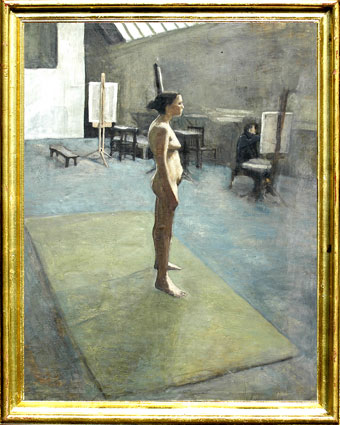
From the Life Painting Room at the Royal Academy
(size 7 feet 6 inches x 6 feet)
Exhibited at the Royal Academy Summer Exhibition.
Charles graduated with a Royal Academy Master of Arts and Bachelor of Arts and won numerous other prizes for Traditional Drawing and Painting. Among these honours, Charles was also later elected to the Livery of the Worshipful Company of Painter-Stainers, becoming their youngest member at the time.
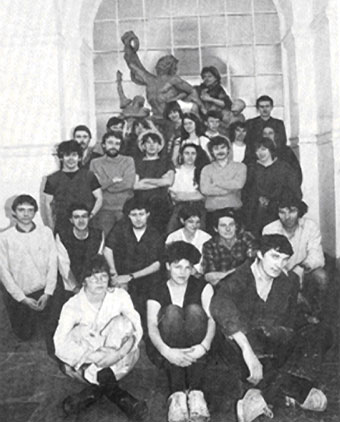
Charles pictured with fellow students at the Royal Academy
(He is on the extreme right of the second front row).
During those six years, he also studied Art History under the tutelage of Prof. David Morris, former Royal Academy Art Historian, who became a dear friend. In support of this study, Charles spent most of his lunch hours at the National Gallery in Trafalgar Square, London.
At this point, Charles realised there was a real need for a return to Traditional Art for the future.
This need became the basis of a paper he later wrote and presented for the Worshipful Company of Painter-Stainers, a City Livery company of London. Clearly entitled: ‘The Necessity of Traditional Art,’ this speech was subsequently incorporated into the curriculum of an American university – The University of North Carolina, Chapel Hill, USA.
During his second three year period at the Royal Academy, at the beginning of his painting career, Charles became increasingly conscious of the effects of a Modern art establishment on the selection of candidates for leading Art prizes and Exhibitions, both in Britain or overseas.
Conscious of the injustice of this Modernist prize selection, or public funding for overseas shows, Charles thereafter avoided these events, showing his intention to break away from this tyranny of Modernism in Art. He also believed the media had incorrectly proclaimed these Modernist events as signals of Success in Art.
Indeed, Britain’s leading art critic Brian Sewell commented on how Charles had “modestly eschewed these major prizes” in a review where he chose Charles as being, “One of the six best painters for the future.” (see reviews under Quotes section).
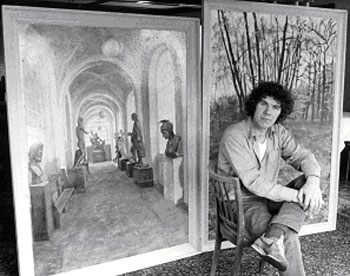
Charles and paintings at the Royal Academy, showing his painting of the Royal Academy corridor on the left.
As a part of the course which he completed under Peter Greenham OBE, Charles was asked to teach private candidates, whom Peter later telephoned to find out how they were getting on.
From this period, it is also worth recalling the words of the late Peter Greenham RA, Former Keeper of the Royal Academy, whom Charles felt privileged to have called a friend.
Charles vividly recalls working one cold November evening, in the quiet of the Royal Academy Life Drawing School, when Peter announced, “Anyone wishing to pursue Traditional Art will find himself swimming against a stream of insensitive Modernism.”
These words could not have been more prophetic and they were to have a profound effect on Charles and his later career.
Standing behind his shoulder, Peter offered this directly to Charles as a task, a challenge and Charles immediately accepted that responsibility inherent within his words.
Upon leaving the Royal Academy, Charles began painting the portraits of many famous people as well as staging a series of one-man Exhibitions in London and Surrey (see ‘Exhibitions’ section).
Charles subsequently painted the portraits of a number of famous people or celebrities. Over an extensive period he regularly received official portrait commissions from the worlds of Politics, the Church, the Military, Business, Entertainment, the Arts, Sport and Education.
Along with numerous other commissions, these requests continue to the present.
They have included:
- Viscount Stormont – Scone Palace
- Viscountess Stormont – Scone Palace
- The Queen of Swaziland – Request received in South Africa
- Lord Steel – The House of Commons London
- Mother Teresa – St. Teresa’s Convent Effingham Sy.
- Mother Veronica – St Theresa’s Convent Effingham Sy.
- Wing Commander Pratt – London
- Col. W.H. J. Sale OBE MC
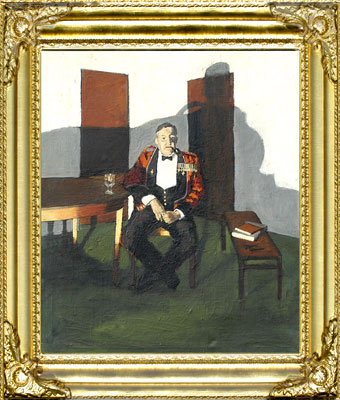
Col. W.H.J. Sale OBE MC by Charles Harris.
Exhibited at the Royal Academy Summer Exhibition.
- Mr John Rees, Headmaster of Blundell’s School.
- Mr G Bulger (President of Kerr McGhee Oil)
- Howard Humphries Board of Directors Group Portrait
- Mr Ossie Stewart, British Olympic Bronze Medallist
- Mrs Sylvia Withington, Royal Opera Company Singer
- Mr Peter Corey, Actor (Private Collection)
- Mr Trevor Byfield, Actor (Private Collection)
- Mr Eddie Durham, New Orleans Veteran Jazz Player
- Mrs.L. Bulger, Vice-president Hoffman-LaRoche Pharmaceuticals (Private Collection)
- Mrs Sofia Dobbs, Horse Racing – Five Sporting Pictures (Private Collection)
- Miss Donna Reid (Private Collection)
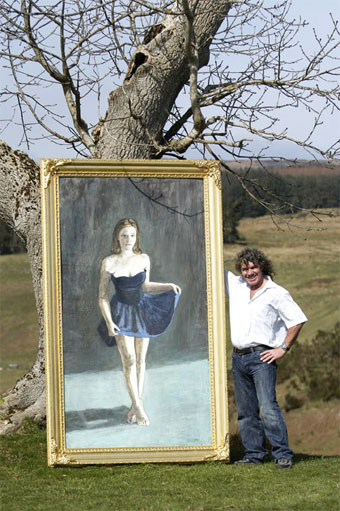
‘Portrait of a Dancer – Miss Donna Reid’
Size proves no problems for Charles as you can see in this portrait of a dancer above!
- Mr Paul Fitzgerald, British & International Speed Skater
- Miss Claudia Sturm, Austrian Ski Team member
- Mr Graham White, British & English Stock Car Racing Champion
- Miss Frances Hillman (Private Collection)
- Miss Kate West (Private Collection)
- Miss Susan Oxford (Private Collection)
- Miss Kirstie Day (Three pictures – Private Collection)
- Mrs Veda McBane – Landscape Commission (Private Collection)
- Mrs Fiona Barron – Former Chair SRYA – Landscape Commission
- Mrs Susan Furneaux – Two Landscape Commissions (Private Collection)
- Mr Oliver Dobbs – Landscape Commission, (Private Collection) USA.
- Mr Tiki Barber, Running Back- The New York Giants, USA
- Miss Victoria Harding (Private Collection)
- The Rev. Dr. Douglas Kelly, Head of Theology, Charlotte University NC. USA (Private Collection)
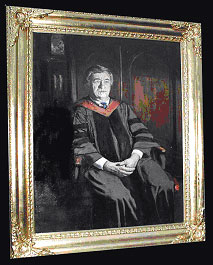
The Rev. Dr. Douglas Kelly by Charles Harris
- Dr. Michael Brown, Dillon Medical Centre, South Carolina. USA
- Miss Charlotte Henderson (Private Collection)
- Lord Carloway – High Court Judge Edinburgh
- Capt. David Hitchcock – London (Private Collection)
- Mrs. David Hitchcock – London (Private Collection)
- Master Craig Henney – (Private Collection)
- Raimondo Ponticelli – Italian National Opera, Florence
(See ‘Pictures’ section for examples of this portraiture.)
His work in business has also included:
- Thompson LGT Telecommunications (French Satellite Electronic Equipment) 2 pictures
- Neil and Spencer’s Ltd (Heavy Plant Manufacturers) England 4 pictures

The Fabrication Welder
- Howard Humphries (Civil Engineers) England 10 pictures
- The Royal Naval Aircraft Works Scotland 6 pictures
- Caithness Glass Scotland 4 pictures
- Leslie Fruit (Wholesale Fruit Growers) Scotland
- Bibby’s Mill (Agricultural Manufacturers) Scotland 2 pictures
- Tescos Stores Scotland 2 pictures
- Heavy Horse Centre Scotland 2 pictures
- The Birnham Hotel Scotland 2 Pictures
- And recently Charles created a new marketing programme for J & D.Wilkie Limited (Scottish Textiles) 16 pictures
- Gianfranco Caputo (Italian Chamber of Commerce) 2 pictures
Upon leaving The Royal Academy Charles was also approached by a leading Education Officer in his area, who had schools, several colleges and a university within his catchment area.
He asked Charles to teach and demonstrate. He also asked him to report back on the condition of Art Education within these establishments.
Eventually, Charles taught at every standard and level, from reception class, to sixth form in schools, plus talks and lectures at colleges and universities.
Thus began an almost unbroken period of teaching and lecturing to the present day with Masterclasses and seminars overseas (see ‘Masterclasses’ page) : an activity he started back at the beginning between portrait commissions and other activities.
During this period, Charles pioneered the first ‘Artist in Residence’ scheme in schools, which was featured on a BBC Six O’Clock News programme.
This project also included a major group painting of schoolchildren, currently held by Surrey County Council.
During this period, Charles’ other activities included a commission from ‘The Artist’ magazine to write a series of articles entitled ‘The Primacy of Tone in Traditional Painting’.
Then, four years after finishing at the Royal Academy, Charles was awarded a prestigious Senior Academic Cultural Exchange Visit to Russia. He represented Great Britain visiting Moscow, St. Petersburg, Pavlosk and the Baltic Coast with a speaking engagement at the Repin Institute in St. Petersburg.
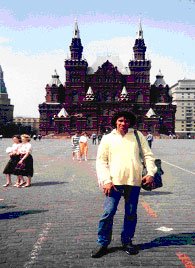
Charles pictured in Red Square Moscow
At this time Charles also co-founded the ‘New Human Realists for New Traditional Art’ with Prof. David Morris, former Royal Academy Art Historian. To this end, they staged a huge exhibition of artworks, entitled ‘Artists For Peace’ Exhibition in Picadilly, London.
Philosophically and historically, Charles believes the values and importance for Art came directly from the Renaissance and was carried forward to the end of the 19th.Century by the Great Tradition in Art. Practically, Charles believes 20th.Century Modern art was by contrast a failure, and 20th.Century abstract conceptual (installation) art a deceit.
Throughout this period he staunchly remained opposed to the views of the British Art Establishments, with their obsessive support for this Modern art and chose to ignore them as a consequence.
Accordingly, Charles continued with his own work, especially painting portraits. He had paintings and drawings exhibited or accepted in numerous public exhibitions beginning with the Royal Academy Summer Exhibition.
Charles also made submissions to a number of the Professional Societies at the Mall Galleries, including – the Royal Society of British Artists, the Royal Institute of Oil Painters, the Royal Society of Portrait Painters, the Royal Institute of Painters in Water-colours, the Pastel Society, the Freestanding Painters and Sculptors, the United Society of Artists, the New English Art Club and he became a member or an associate member of many of these Professional Societies at the Mall.
Charles was then honoured by a picture request from Her Majesty Queen Elizabeth II for the Royal Collection at Buckingham Palace, London.
Shortly afterwards, Charles undertook a ‘Round the World Painting Tour’ for charity and made many beautiful pictures of sunrises and sunsets, especially in Spain, Portugal, Thailand and Australia.
Charles has spent much of his life in England and Scotland, (see pictures below) – A hotel in England, a house in Scotland. Both influenced his thinking and, professionally, the nature of the artwork he completed.
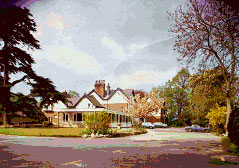
Hotel in England
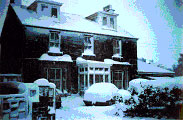
House in Scotland
Besides painting the portraits of many people, Charles also has an international reputation as a leading Landscape painter.
Eventually he turned to Scotland and began painting those heroic Perthshire pictures that have made his reputation overseas.
They are usually large oil paintings, frequently 3 feet by 4 feet, always presented with a traditional 6 inch wide gold-leafed frame, imported from Italy. (for examples see ‘Paintings’ section).
Practically, Charles always works entirely in front of the subject, outside in all weathers, anywhere in the world. In the winter in Scotland, to the amusement of many estate game-keepers, he was frequently seen painting in the middle-of-nowhere, with snow squalls approaching. To this country workforce, his level of commitment and apparent eccentricity was the subject of many jokes and professional respect.
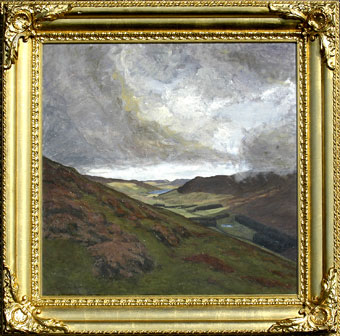
View Through Glen Quaich by Charles Harris
Throughout this period, summer or winter, Charles remained a contemporary traditional artist who never worked from photographs, leaving these ideas, he believed, for modern artists.
In practice, his traditional landscape paintings of Scotland usually took months to complete. While the quality of this work led to the praise and acclaim he received from the exhibitions he staged overseas, including ‘The Best Unofficial Ambassador for Scotland.’
Academically his work has been considered to be on a par with artwork held in major national collections. In Britain, his work is held in both Royal Collections, two in Buckingham Palace for Her Majesty Queen Elizabeth II and two at St. James’ Palace for HRH the Prince of Wales. The Prime Minister the Rt. Hon. Tony Blair also has one of Charles’ pictures.
In Scotland, Charles was invited to work on the film set of the motion picture ‘Rob Roy’, and completed pastel studies, watercolours and portraits drawings of Michael Caton-Jones, Bill Westley, John Hurt, Liam Neeson, Andrew Keir, Tim Roth, Jessica Lange, as well as Karen Matheson with the Scottish folk group Capercaillie.
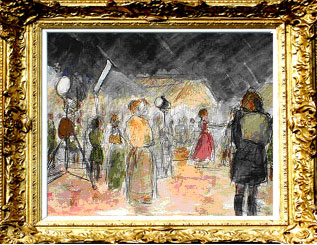
Watercolour Painting of Capercaillie on the set of Rob Roy
Charles was always a genuine original thinker. He rejected the British Art institutions with their support for modern public art and modern installation art exhibitions paid for from the public purse. He believed that Art should stand in the market place and have a commercial price alongside everything else. This naturally allowed the public to make their own decisions, make value judgments and exercise proper choice instead of simply being told what is good or what to think!
Prophetically, Lesley Riddoch of the BBC said, “Charles has been the lone voice in the wilderness for Traditional Art.”
Undismayed by the antics of so-called Modern artists, Charles launched his ‘New Traditional ArtTM’onto the world stage with a World Tour of his work.
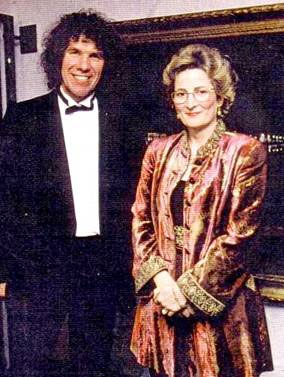
Viscountess Stormont with Charles Harris MA BA
Viscountess Stormont was the official Patron for the
opening year of the World Tour Exhibitions
Beginning at the SECC Glasgow in Scotland, the World Tour has included Belfast and Dublin in Ireland, New York and both North and South Carolinas in the USA, Nizhny Novgorod in Russia, Brittany in France, Johannesburg in South Africa, Hong Kong, Florence in Italy and Earls Court in London.
World Tour Exhibitions
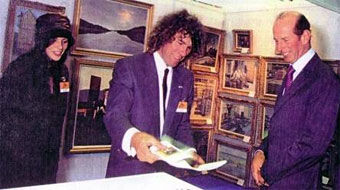
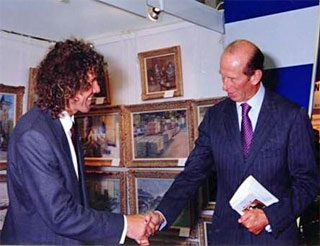
The Duke of Kent with Charles Harris MA BA
This large public exhibition was staged in Nizhny Novgorod,
Russia and opened by the Duke of Kent
(See section entitled ‘Exhibitions’)
Charles also completed a number of smaller, private exhibitions, including a Royal request for a private Exhibition in Rome.
A Private Exhibition for HRH The Prince of Wales:
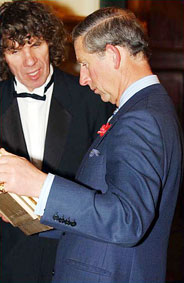

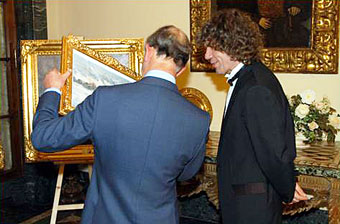
H.R.H. The Prince of Wales with Charles Harris MA BA
This private exhibition was staged for H.R.H. The Prince of Wales at the British Ambassadors Residence in Rome. November 2002.
The largest of Charles’ exhibitions was at The Landmark in Hong Kong which came about as a result of a kind, private invitation from Sir Percy Weatherall (See section entitled ‘Exhibitions’).
In Hong Kong he was invited to display his work in the Atrium of ‘The Landmark’ No.1 Hong Kong by The Taipan of Hong Kong Sir Percy Wetherall.
(One of the wealthiest men in the world
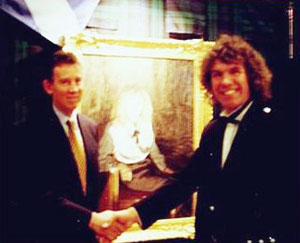
The exhibition was officially opened by Chief Executive of Hong Kong Land Nicholas Sallnow-Smith who kindly hosted the event.
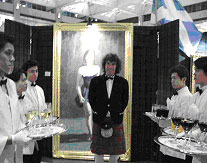 Charles awaits his guests at his Exhibition at The Landmark in Hong Kong with Silver Service Catering by Maxim’s of Paris |
|
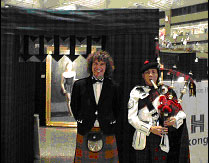 The Opening of the Show in Hong Kong |
|
Reacting to the closed elitism of British Arts Councils and their satellites with their apparent bias towards Modernism, Charles deliberately chose very large public venues to show his work.
Professionally, these events received extensive television, radio and media coverage (See ‘Exhibitions’ page).
In concluding this passage on Exhibitions we include an example of the popularity of Charles’ shows with an exhibition he staged at Earls Court in London with a special request from several models from ‘Models One’ to pose and be photographed in front of his work.
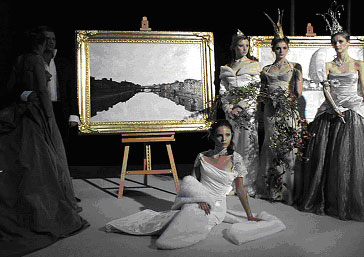
The paintings of Charles Harris with the models from ‘Models One’ pictured at Earls Court London
(for more details see section entitled ‘Exhibitions’)
With increasing Exhibition demands and for Seminars and Masterclasses overseas, Charles now found his priorities changing away from this previously intense show programme.
At one point he staged four exhibitions in four different locations throughout the world all in the same week.
Nevertheless, an increased demand for his work, or exhibitions, plus his own desire to raise the standard of his Art, meant that too many shows with all the associated administration, became an ineffective use of his time. Still this experience proved invaluable adding to his expertise and making him aware of the needs for Art in the Business world. All this was possible because of the standards Charles achieved in his work and the strong honest views he retained.
Recently –
Charles received a commission from the Roman Catholic Church to support the restoration of a Scottish Monastery, with a series of other activities, including talks and Seminars to assist this charitable purpose.
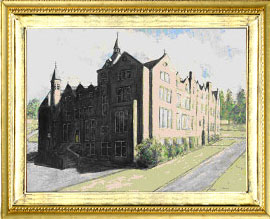
St. Mary’s Monastery by Charles Harris
Again recently, Charles has been engaged in painting Sport. This is an idea he has perused since the beginning of his career. An active sportsman himself, he has always been keen to renew the traditional connection between Art and Sport. ( See ‘Art and Sport’ section)
As an art consultant –
Charles has been placed on the books of one of our leading Insurance companies for revaluation and damage assessment work.
Advice and consultancy have also become a regular activity area for Charles along with an increase in significant invitations for talks and seminars.( See ‘Pictures’ and ‘Consultancy’ sections)
Throughout his career, Charles has covered every aspect of his profession which has included the work of restoration.
Almost immediately he left the Royal Academy, Charles began to receive requests for the restoration of Past-Masters.
Among the artists he has restored were: A painting of Venice by Canaletto (private collection); a major early Renaissance painting believed to be a Giotto (private collection); a number of Scottish painters including a Farquharson landscape (private collection); several Ferguson landscapes (private collections) and works by other minor artists both in oils and watercolours.
In the past two years, Charles was honoured to receive subsequent requests to provide a series of talks at Earls Court in London for the Italian Exhibition. The subject of these talks was Italian Renaissance painting, in which he is now considered an authority.
He also received a similar request for talks on Spanish painting, for the Spanish Exhibition, also in London.
In concluding this series of events, as always, in the face of the absurdities of Modern Art, Charles has been engaged in a cultural mission to re-introduce the standards and values of Traditional Art to a world stage.
Within the Great Tradition, all great artists held firm opinions.
Accordingly, Charles was less than impressed by the weak voices in traditional art, who have kept quiet during this period, rather than speak out against the injustice to Art which was constantly occurring.
After a long period of proud isolation, Charles now waits with expectation, as the pendulum swings back for reform, as others raise their voices, desiring to see a proper change.
He said, “In every sense, we must see a return to the ideas, standards and values of the Great Tradition. – In the Art of Painting, tonal values and accurate drawing, which were the keystone to the Great Tradition in Art, must reappear on canvas.”
Practically, be it a Landscape, Portrait or still Life, this traditional realist approach has been the very essence of Charles work, generating sales and commissions throughout the world. The demand for his work, plus the success of his exhibitions, clearly indicate the growing international appeal and ongoing support for his conservative but radical ideas.
Academically, during his career Charles has written many papers on Traditional Art but now he has completed his authoritative and controversial new book entitled ‘Trust Your Eye- an Illustrated History of Painting’ for publication in October 2007.
It has been a book that many of us have long waited for and we owe a large vote of thanks to Father Jim McManus for providing the final impetus.
And, finally, we want to thank all of you who have taken the time to read this, new acquaintances or old trusted friends alike. We appreciate it very much!



